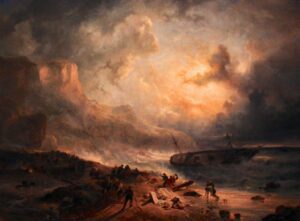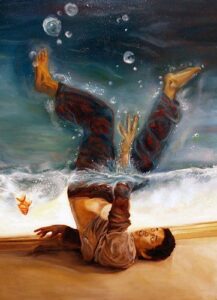Romanticism art marks a period where emotion reigned supreme, and artists broke free from the shackles of order and reason.
It’s a movement that championed individuality, nature’s majesty, and the deep well of human emotion.
In this article, we’ll dive into the heart of Romanticism, exploring how it reshaped the art world and influenced the masterpieces we still celebrate today.
We’re about to unravel the rich tapestry of this era, from its passionate brushstrokes to the rebellious spirits that defined it, ensuring you’ll come away with a newfound appreciation for this pivotal artistic revolution.
The Origins Of Romanticism
Romanticism blossomed as a response to the Enlightenment, where reason and empirical evidence were the dominant forces.
We saw artists rejecting this rational approach, diving instead into the turbulent waters of emotion and individualism.
The period kicked off around the 1800s, as a pushback against the Industrial Revolution’s stifling effects on the human spirit and creativity.
The movement spread swiftly across Europe, with each nation interpreting Romanticism through its own cultural lens.
In Germany, artists like Caspar David Friedrich showcased the sublime power of nature, while in Britain, William Turner depicted the uncontrollable forces of the sea and sky.
These artists set the stage for an era where expressing one’s inner turmoil and embracing the allure of the exotic and the historical was
We recognize key figures like Eugene Delacroix in France and Francisco Goya in Spain for their contributions to Romantic art.
Their canvases were wild with color and movement, often portraying scenes fraught with emotional intensity.
Delacroix’s Liberty Leading the People and Goya’s The Third of May 1808 are testaments to the restless spirit of the time, capturing the zeitgeist of revolution and change.

Characteristics Of Romantic Art
Romantic art marks a period where emotion reigned supreme over reason.
At its core, this movement sought to evoke powerful feelings and emphasize the sublime.
We see this through the dramatic use of color, light, and shadow that artists like Delacroix and Turner mastered.
They painted tempestuous oceans and fiery skies as a way to capture nature’s overwhelming force.
Artists also turned to the past for inspiration, often depicting scenes from history, mythology, and literature.
In Liberty Leading the People, Delacroix immortalized the spirit of revolution.
Similarly, Friedrich’s works often seem to stand as metaphors for human emotion, with figures gazing into vast, mysterious landscapes.
Works during this era were loaded with symbolism and intended to stir the viewer’s innermost feelings.
Characterized by their expressive brushstrokes, Romantic paintings seem to dance with energy.
The technique highlighted the artists’ individuality and often appeared to be almost in motion — this was a stark contrast to the polished finish of Neoclassical works.
It’s these unique qualities that made Romantic art distinct and that continue to captivate us to this day.
The fascination with exotic cultures and the inherent beauty in the unfamiliar can’t be overlooked.
Orientalism, as part of Romanticism, allowed Western artists to portray Eastern scenes grounded in fantasy.
Such works brought an element of intrigue and fantasy into European art, broadening the horizons of viewers and artists alike.
The Influence Of Nature
The Romantic movement forged a profound bond between art and the natural world.
We find landscapes standing as one of the most celebrated subjects—often brimming with a sense of awe and the divine.
Nature wasn’t just a backdrop in Romantic art; it was a key player, reflecting the inner emotional state of mankind.
Artists like Caspar David Friedrich elevated nature to a spiritual plane.
In his works, we encounter the sublime—nature’s sheer power and scale overshadowing the figures within it.
It’s this inherent beauty and terror of the unpredictable that Romantic artists aimed to capture, suggesting the uncontrollable forces to which humanity is subject.
Nature also served as a sanctuary from industrialization, a theme that resonates through many pieces of the era.
Poetic and mysterious, these portrayals juxtaposed the machines of the age with the timelessness of the natural world.
The elements became characters full of unpredictable fury and tranquil beauty, mirroring the tumultuous social changes of the times.
Romanticism’s emphasis on individual experience meant that each depiction of nature was deeply personal.
The sun-flecked canvases of William Turner evoke an almost impressionistic portrayal of atmosphere and light.
Such artworks remind us that the Romantic era was as much about internal landscapes as external ones.
Emotion And Individuality In Romantic Art
Romantic art heralds a deep dive into the tempestuous seas of human emotion.
In contrast to the stoic restraint of neoclassicism, Romantic artists swam in the currents of passion, sorrow, and transcendent joy.
Their brushstrokes narrated tales of personal triumph and despair, revealing their own hearts upon the canvas.
This era’s embrace of individuality shattered artistic conventions, fostering a belief in the artist’s unique vision as the wellspring of creation.
It’s this commitment to personal expression that allows us to explore filmmakers like Terrence Malick, whose works such as Days of Heaven reflect the Romantic tradition’s influence in modern storytelling.
In Romantic art, each piece whispers a secret about its creator; every splattered shade or contoured line discloses a fragment of their emotional reality.
We find these same principles at work in contemporary cinema—directors like Guillermo del Toro channel this legacy through their film’s aesthetics, in movies like Pan’s Labyrinth, where the fantastical intertwines with the emotional depth of characters.
Rebels And Outcasts: The Romantics’ Approach To Society
The Romantics challenged the status quo, often portraying characters and narratives that deviated from societal norms.
They embraced the
These themes aren’t just relics from the past; they resonate in the storylines of modern films where the protagonists defy conventions, forging new paths against all odds.
In their quest for authenticity, Romantic artists frequently cast their gaze upon the outcasts and rebels of society.
Their work often depicts a sympathy for the plight of those marginalized by mainstream culture.
This empathy for the outsider finds its echo in the antiheroes and mavericks of today’s cinema, characters who garner our empathy and often, ironically, our admiration.
The Romantics’ disdain for the rigid structures of their time is evident in their art.
They were not afraid to shock their audience with new, unorthodox ideas.
Their legacy is a diverse body of work that continues to influence the aesthetics and thematic choices in current storytelling.
The Romantic influence can be seen in the rich, complex narratives of contemporary films that encourage viewers to question their beliefs and the societal norms around them.
It’s in the restless spirit of the Romantic movement that we find the seeds of modern character development and plot construction.
Their emphasis on individualism and personal emotion paved the way for the deep character studies that are prevalent in the films of today.
Through these stories, the lineage from Romantic art to the complex narratives in film becomes a vivid thread, weaving through the fabric of creative expression.
Romanticism’s Impact On The Art World
Romanticism, with its impassioned embrace of the individual’s experience, irreversibly altered the art world.
We saw creative expression become a personal journey, and this shift enfranchised artists to navigate beyond the formal constraints present in earlier periods.
Freed from these boundaries, Romanticism heralded a new era of artistic exploration, setting the stage for various modern art movements.
The tenets of Romanticism championed emotion over reason, and this fundamental change resonated across artistic genres.
In cinema, we witness this legacy in films that prioritize character development and emotional complexity.
Romantic ideals are deeply woven into the fabric of narrative-driven films, illustrating the lasting influence of the movement.
As the Romantic movement prized the sublime and the exotic, so have filmmakers sought to capture breathtaking visuals and stories set against magnificent backdrops.
Look no further than the grandeur of Lawrence of Arabia or the vastness of space in Interstellar.
These films reflect Romanticism’s impact, not just through their narrative but also through their visual storytelling, using innovative techniques to evoke profound emotional responses.
Moreover, Romanticism’s influence on conceptualizing the antihero undeniably shaped the protagonists we now see on screen.
Characters that embody both the flawed human condition and the search for identity echo the Romantics’ fascination with the outcast.
Modern films frequently exhibit this complexity, enabling viewers to engage with characters on a deeper, more introspective level.
Throughout the art world, the echoes of Romanticism persist.
Its impact is clear as we continue to see a celebration of individualism and emotion in contemporary works.

From the brush to the lens, Romanticism’s principles guide us, inviting audiences to explore human experiences that are as vast and varied as nature itself.
Romanticism Art – Wrap Up
We’ve journeyed through the rich tapestry of Romanticism in art and its enduring legacy.
The movement’s deep roots in emotion and individualism continue to shape our cultural landscape, particularly in the realm of film.
As we reflect on the Romantics’ passion for personal expression and their challenge to societal norms, we see their spirit alive in today’s narrative-driven stories.
These themes of defiance, exploration, and the celebration of the human spirit resonate with audiences, reminding us that the heart of Romanticism beats on in our modern world.
Let’s carry forward the lessons of Romantic art, embracing our own individuality and the power of emotional storytelling.
Frequently Asked Questions
What Is Romanticism In Art?
Romanticism in art was a movement that emphasized emotion, individualism, and the glorification of nature.
It represented a break from the strict rules of prior art movements, focusing instead on personal expression and artistic freedom.
How Did Romanticism Influence Modern Storytelling?
Romanticism influenced modern storytelling by inspiring the use of complex characters, emotional narratives, and themes of individual triumph and defiance against societal norms.
These elements are prevalent in modern film and other narrative mediums.

What Role Did Nature Play In Romantic Art?
Nature was central to Romantic art, serving as a symbol of the sublime and emotional inspiration.
Artists of the Romantic period often used nature to express feelings of awe, transcendence, and inner turmoil.
How Are Romantic Themes Portrayed In Modern Films?
Modern films often portray Romantic themes through narratives that challenge societal expectations, focus on character development, and showcase an individual’s journey towards self-discovery.
Rebels and outcasts are common protagonists.
What Is The Significance Of The Antihero In Romanticism And Modern Films?
The antihero, stemming from Romantic ideals, is significant for its embodiment of the flawed human condition and the complex search for identity.
Modern films frequently feature such characters to explore moral ambiguities and personal struggles.
How Did The Romantic Movement Pave The Way For Character Studies In Film?
The Romantic movement’s emphasis on emotional depth and individuality set the foundation for deep character studies in film, allowing for narratives that engage viewers in the internal conflicts and growth of complex characters.
In What Ways Is Romanticism’s Influence Visible In Aesthetic Choices In Film?
The influence of Romanticism is visible in film through visual storytelling techniques that evoke strong emotional responses, often mirroring the dramatic, sensual, and picturesque qualities of Romantic art.


